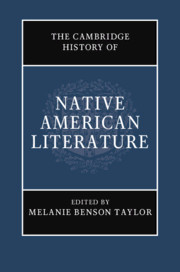Book contents
- The Cambridge History of Native American Literature
- The Cambridge History of Native American Literature
- Copyright page
- Contents
- Figures
- Contributors
- Introduction: What Was Native American Literature?
- Part I Traces and Removals (Pre-1870s)
- Part II Assimilation and Modernity (1879–1967)
- Part III Native American Renaissance (Post-1960s)
- Part IV Visions and Revisions: 21st-Century Prospects
- 23 Native American Horror, Fantasy, and Speculative Fiction
- 24 Charting Comparative Indigenous Traditions
- 25 The Global Correspondence of Native American Literatures
- 26 Indigenizing the Internet
- 27 Indigenous Futures beyond the Sovereignty Debate
- 28 The Leftovers
- 29 Can You See the Indian?
- Index
- References
26 - Indigenizing the Internet
from Part IV - Visions and Revisions: 21st-Century Prospects
Published online by Cambridge University Press: 18 September 2020
- The Cambridge History of Native American Literature
- The Cambridge History of Native American Literature
- Copyright page
- Contents
- Figures
- Contributors
- Introduction: What Was Native American Literature?
- Part I Traces and Removals (Pre-1870s)
- Part II Assimilation and Modernity (1879–1967)
- Part III Native American Renaissance (Post-1960s)
- Part IV Visions and Revisions: 21st-Century Prospects
- 23 Native American Horror, Fantasy, and Speculative Fiction
- 24 Charting Comparative Indigenous Traditions
- 25 The Global Correspondence of Native American Literatures
- 26 Indigenizing the Internet
- 27 Indigenous Futures beyond the Sovereignty Debate
- 28 The Leftovers
- 29 Can You See the Indian?
- Index
- References
Summary
This chapter engages with the Internet as a discursive realm where the profound conflicts generated by settler-colonialism continue to be played out. In the dynamic space of the Internet, Indigenous digital storying is a claim to rhetorical sovereignty that articulates Native self-determination through specific ways of knowing and being. A powerful statement of Indigenous self-determination is the use of mobile locative media – “Mapping Indigenous LA” (Gabrielino/Tongva and Tataviam), Knowing the Land beneath Our Feet (Musqueam), and Finding Sacred Ground (Lakota) – to create a digital remapping of Native geography, denaturalizing settler cartographies and restoring Native storying to the land, while two dominant “digital Native” forms of storying that use the capabilities of virtual media in conjunction with traditional literary genres to instantiate Indigenous cosmologies are the digital film-poems or “poemeos” exemplified by Heid Erdrich’s Anishinaabe storying, aas well as Elizabeth LaPensée’s Anishinaabe/Métis storying through Indigenously-determined digital narrative or videogames.
Keywords
- Type
- Chapter
- Information
- The Cambridge History of Native American Literature , pp. 481 - 500Publisher: Cambridge University PressPrint publication year: 2020
References
- 1
- Cited by



